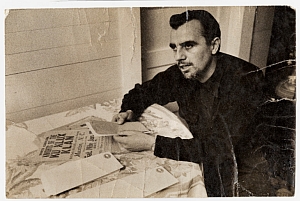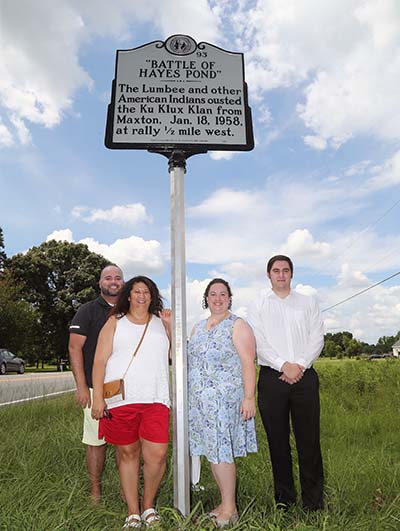"This Month in North Carolina History" series. Reprinted with permission.
On the night of January 13, 1958, crosses were burned on the front lawns of two Lumbee Indian families in Robeson County, N.C. Nobody had to ask who was responsible. The Ku Klux Klan had risen again in North Carolina, its ranks swelling after the 1954 Supreme Court decision in Brown v. Board of Education calling for the desegregation of public schools. While the Court instructed schools to proceed with "all deliberate speed," the Klan fought — often in the form of anonymous nighttime attacks — to slow the process of integration.
Robeson County in the 1950s had a uniquely triracial population. There were about 40,000 whites, 30,000 Native Americans, and 25,000 African Americans, each group with its own separate school system. Although the Klan had typically targeted African Americans, in early 1958 a group led by James W. "Catfish" Cole of South Carolina began harassing the Lumbees. One of the crosses burned on the night of January 13 was on the lawn of a Lumbee family that had recently moved into a predominantly white neighborhood, while the other was intended to intimidate a Lumbee woman who was said to have been dating a white man. Not content to leave it at this, the Klan planned a rally in Robeson County to be held just a few days later.
The rally was scheduled for the night of January 18, 1958, in a field near Maxton, N.C. The stated purpose of the gathering was, in the words of Catfish Cole, "to put the Indians in their place, to end race mixing." The time and location of the rally was not kept secret, and word spread quickly among the local Lumbee population.
Reports vary about the number of people gathered on that cold night, but there were thought to have been around a hundred Klan members. They brought a large banner emblazoned with "KKK" and a portable generator, which powered a public address system and a single bare light bulb. When the meeting began, the arc of the dim light didn't spread far enough for the Klansmen to see that they were surrounded by as many as a thousand Lumbees. Several young tribe members, some of whom were armed, closed on the Klan meeting and tried to take down the light bulb. The groups fought, and a shotgun blast shattered the light. In the sudden darkness, the Lumbees descended upon the field, yelling and firing guns into the air, scattering the overmatched Klansmen. Some left under police protection while others, including Catfish Cole, simply took to the woods.
News photographers already on the scene captured the celebration. Images of triumphant Lumbees holding up the abandoned KKK banner were published in newspapers and magazines throughout the world. Simeon Oxendine, a popular World War II veteran, appeared in Life magazine, smiling and wrapped in the banner. The rout of the Klan galvanized the Lumbee community. The Ku Klux Klan was active in North Carolina into the 1960s, but they never held another public meeting in Robeson County.
Bad Medicine for the Klan: North Carolina Indians Break Up Ku Kluxers' anti-Indian Meeting (Life magazine, January 27, 1958, pp. 26-28) - Trouble between the Indians and the Ku Klux Klan had been simmering for a week in Robeson County, N.C. In its continuing efforts to keep Robeson County's three-way segregation rigid, the Klan had recently burned crosses to warn an Indian family that moved into a white neighborhood and an Indian woman who dated a white man.

